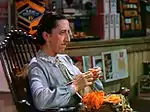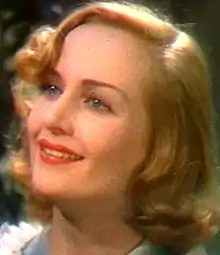| Nothing Sacred | |
|---|---|
.jpg.webp) Theatrical release poster | |
| Directed by | William A. Wellman |
| Written by |
|
| Based on | "Letter to the Editor" 1937 short story Cosmopolitan by James H. Street |
| Produced by | David O. Selznick |
| Starring | |
| Cinematography | W. Howard Greene |
| Edited by | James E. Newcom |
| Music by | Oscar Levant |
Production company | |
| Distributed by | United Artists |
Release date |
|
Running time | 77 minutes |
| Country | United States |
| Language | English |
| Budget | $1.3 million[1] |
| Box office | $2 million (U.S. and Canada rentals)[2] |
Nothing Sacred is a 1937 American Technicolor screwball comedy film directed by William A. Wellman, produced by David O. Selznick, and starring Carole Lombard and Fredric March with a supporting cast featuring Charles Winninger and Walter Connolly. Ben Hecht was credited with the screenplay based on the 1937 story "Letter to the Editor" by James H. Street, and an array of additional writers, including Ring Lardner Jr., Budd Schulberg, Dorothy Parker, Sidney Howard, Moss Hart, George S. Kaufman and Robert Carson made uncredited contributions.
The lush, Gershwinesque music score was by Oscar Levant, with additional music by Alfred Newman and Max Steiner and a swing number by Raymond Scott's Quintette. The film was shot in Technicolor by W. Howard Greene and edited by James E. Newcom, and was a Selznick International Pictures production distributed by United Artists. The film's opening credits feature distinctive caricatures of the leading actors, as 3d-figurines, and creative artists, as 2d-cartoons, by Sam Berman.[3]
This was Lombard's only Technicolor film. She stated that this film was one of her personal favorites.
Plot
New York newspaper reporter Wally Cook is blamed for reporting a Harlem bootblack Ernest Walker as a nobleman "of the Orient" hosting a charity event. Cook claims he was unaware, but he is demoted to writing obituaries. He begs his boss Oliver Stone for another chance, and points out a story about a woman, Hazel Flagg, reportedly dying of radium poisoning. Cook is sent to the (fictional) town of Warsaw, Vermont, to interview Hazel. Cook finally locates Hazel, who is crying both because her doctor has told her that she is not dying and because she realizes she might be stuck in Vermont for her whole life. Unaware of this, Cook invites Hazel and her doctor to New York as guests of the Morning Star newspaper.
The newspaper uses her story to increase its circulation. She receives a ticker-tape parade and the key to the city, and becomes an inspiration to many. She and Wally fall in love, and he asks her to marry him even though he still thinks she's dying. After a medical exam by three independent doctors, it is finally discovered that Hazel is not really dying, and city officials and Stone decide that it would be better to avoid embarrassment by having it seem that she went off to die, "like an elephant". Hazel and Wally get married and quietly set sail for the tropics.
Cast


- Carole Lombard as Hazel Flagg
- Fredric March as Wally Cook
- Charles Winninger as Dr. Enoch Downer
- Walter Connolly as Oliver Stone
- Sig Ruman as Dr. Emil Eggelhoffer (as Sig Rumann)
- Frank Fay as master of ceremonies
- Troy Brown as Ernest Walker
- Maxie Rosenbloom as Max Levinsky
- Margaret Hamilton as Vermont drugstore lady
- Hattie McDaniel as Mrs. Walker
- Olin Howland as Will Bull
- Raymond Scott as musical leader
- John Qualen as fireman (uncredited)
- George Chandler as photographer (uncredited)
According to William Wellman Jr., Janet Gaynor had originally been cast as Hazel Flagg to follow on the success of A Star is Born (1937). However, after William Wellman Sr. met Carole Lombard, he convinced Selznick to cast her.
A boxing world champion, Maxie Rosenbloom, gave Lombard boxing lessons to prepare her for her fight scene with Fredric March.
Production


The first screwball comedy filmed in color, Nothing Sacred also represents the first use in a color film of process effects, montage and rear screen projection. Backgrounds for the rear projection were filmed on the streets of New York. Paramount Pictures and other studios refined this technique in their subsequent color features.[4]
Ben Hecht is credited with writing the screenplay in two weeks on a train. He adapted the story "Letter to the Editor" by James H. Street which had been first been published in Hearst's International-Cosmopolitan.[5] Hecht wrote a role for his friend John Barrymore in the film, but David Selznick refused to use him as Barrymore had become an alcoholic. This caused a rift between Hecht and Selznick, and Hecht walked off the picture.[4] Budd Schulberg and Dorothy Parker were called in to write the final scenes and several others also made contributions to the screenplay, including: David O. Selznick, William Wellman, Sidney Howard, Moss Hart, George S. Kaufman and Robert Carson.
One reason that the film is considered among the most celebrated screwball comedies is that underneath the humor, it incorporates sharply cynical themes of corruption and dishonesty. This film, along with Hecht's The Front Page (1931) and its 1940 remake His Girl Friday with Cary Grant, caricatures the chicanery to which some newspapers resorted in order to get a "hot" story.
Reception
Despite received critical acclaim, the film recorded a loss of $350,000 at the box office.[6] In July 2018, it was selected to be screened in the Venice Classics section at the 75th Venice International Film Festival.[7]
Copyright and home media
In 1965, the film entered the public domain in the United States because the copyright owners did not renew its copyright registration in the 28th year after publication.[8]
Because of its public domain status, the film is a staple of bargain bin releases and collections. Although it was generally in watchable condition, until recently the best DVD was a US region 0 disc from Lumivision, later reissued by Sling Shot. In 2011, Kino Lorber issued the film on DVD and Blu-ray, mastered from a 2K scan of Selznick's personal nitrate print, preserved by the George Eastman House Motion Picture Department. In 2018, Kino reissued their Blu-ray, this time mastered from a 2K scan of Disney's 1999 restoration, carried out on behalf of ABC, holder of most of the Selznick library.[9]
Remakes
Ben Hecht's screenplay was also the basis of a Broadway musical Hazel Flagg (1953), with Helen Gallagher, as well as Living It Up (1954), a comedy film starring Dean Martin in the Winninger role, Jerry Lewis in the Lombard role (as Homer Flagg), and Janet Leigh in the March role.
References
- ↑ Thomson, David (1993). Showman: The Life of David O. Selznick. Abacus. p. 262.
- ↑ Cohn, Lawrence (October 15, 1990). "All-Time Film Rental Champs". Variety. p. M-176. ISSN 0042-2738.
- ↑ "Art of the Title".
- 1 2 "Nothing Sacred". Turner Classic Movies.
- ↑ "Calendar - UCLA Film & Television Archive". www.cinema.ucla.edu.
- ↑ Earnings Report, Nov. 1940, Folder 10, Box 628, David O. Selznick Collection, Harry Ransom Center; University of TX-Austin. See also Emily Carman, Independent Stardom: Freelance Women in the Hollywood Studio System (Austin: University of Texas Press, 2016), 184; ISBN 9781477307311
- ↑ "Biennale Cinema 2018, Venice Classics". labiennale.org. 13 July 2018. Retrieved 22 July 2018.
- ↑ Fishman, Stephen (2010), The Public Domain: How to Find & Use Copyright-Free Writings, Music, Art & More (5th ed.), ISBN 978-1-4133-1205-8
- ↑ "First Person: Restoring Film with Digital Recombination". Archived from the original on 2001-04-06. Retrieved 23 November 2018.
External links
- Nothing Sacred at IMDb
- Nothing Sacred at AllMovie
- Nothing Sacred at the American Film Institute Catalog
- Nothing Sacred at the TCM Movie Database
- Watch Rare Films from Our Vaults – the restored Nothing Sacred, amongst others, at the Dryden Theatre
- First Person: Restoring Film with Digital Recombination Digital Content Producer – article on the 1999 restoration
- Nothing Sacred is available for free viewing and download at the Internet Archive
- Nothing Sacred on Lux Radio Theater: November 11, 1940